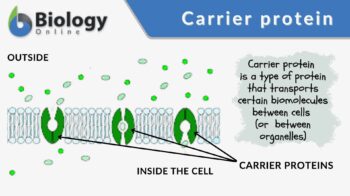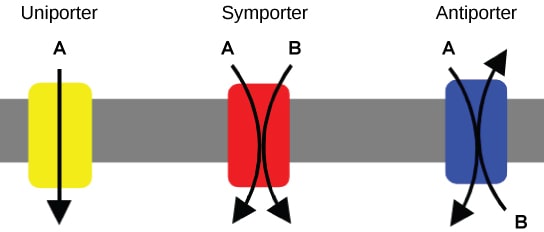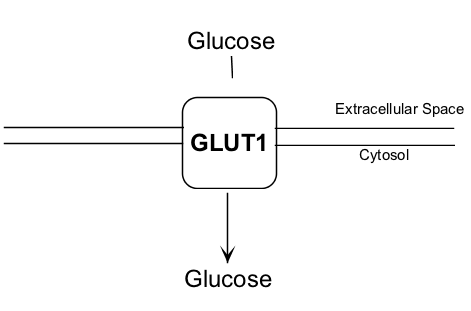
Carrier protein
n., plural: Carrier proteins
[ˈkæ.ɹɪ.ɚ ˈpɹəʊti.ɪn]
Definition: a type of cell membrane protein involved in transport
Table of Contents
Carrier protein is a type of cell membrane protein involved in facilitated diffusion and active transport of substances out of or into the cell. Carrier proteins are responsible for the diffusion of sugars, amino acids, and nucleosides. They are also the proteins that take up glucose molecules and transport them and other molecules (e.g. salts, amino acids, etc.) inside the cell.
For instance, carrier proteins such as the integral transmembrane proteins embedded in the cell membrane would have a high affinity for specific substances on the cell exterior and would next undergo a conformational change to facilitate the passage of these substances to the cell interior across the membrane barriers.
Carrier Protein Definition
In biology, a carrier protein is a type of protein that transports a specific substance through intracellular compartments, into the extracellular fluid, or across cells as opposed to channel proteins, which is another membrane transport protein, that is less selective in transporting molecules. Similar to other membrane transport proteins, carrier proteins are located in lipid bilayers cell structures, such as cell membranes, mitochondria, and chloroplasts.
Carriers vs. Channel-formers
Carrier proteins are membrane transport proteins along with the channel proteins. As membrane transport proteins, they are located in biological membranes and their primary function is to move molecules from one site to another. These transporters though differ in certain aspects.
Channel proteins, as their name implies, form a ”channel” that serves as a passageway for molecules to pass through. They are firmly and permanently situated in the plasma membrane, with their hydrophobic domains interacting with the membrane’s lipids.
Channels that remain open to both the cell’s interior and exterior are referred to as pores. Aquaporin is an example of a channel protein in the cell membrane that allows water molecules to flow through. Conversely, carrier proteins do not form channels. Rather, they have binding sites from where molecules can bind to. Then, they shuttle the molecules towards their destination, i.e. the membrane’s interior or exterior. Having binding sites indicate that carrier proteins are more selective to the molecules that they transport. Furthermore, they are not simultaneously open to both the interior and the exterior of the cell unlike certain channel proteins, specifically, porins, that are open on both sides at the same time. Thus, unlike porin channels, carrier proteins are capable of transporting molecules against their concentration gradient, as in active transport.
Types of Carrier Proteins
Carrier proteins that are involved in the active transport of molecules or substances may be classified based on the transport activity that they are in. Carrier proteins that are involved in carrier-mediated diffusion are those that are driven by a concentration gradient and not by ATP hydrolysis. They transport molecules from an area of high concentration to an area of low concentration. Examples are carrier proteins involved in the facilitated diffusion of sugars, amino acids, and nucleosides across cell membranes of most cells. (Ref. 1)
Carrier proteins that transport molecules against the concentration gradient are those that use substantial energy. Depending on the energy source, the carrier proteins may be classified as (1) ATP-driven, (2) electrochemical potential-driven, or (3) light-driven. ATP-driven carrier proteins are those requiring ATP to transport molecules whereas electrochemical potential-driven proteins are those fueled by electrochemical potential. Light-driven pumps are pumps that are driven by photons. These pumps are commonly found in bacterial cells. (Ref.2) The first two are further described below.
ATP-driven carrier proteins
ATP-driven carrier proteins are those that require ATP coupling to move molecules. A specific carrier example that is ATP-driven is the sodium-potassium pump in the plasma membrane of animal cells. The pump specifically binds to the sodium and potassium ions. In order to sustain homeostasis, this pump maintains appropriate levels of such ions. To do that, the pump actively moves 3 sodium ions (Na+) from the inside of a cell and then replaces them with 2 potassium ions (K+) from the outside for each ATP molecule it uses. This form of active transport wherein chemical energy (ATP) fuels the process is called primary active transport.
Electrochemical potential-driven carrier proteins

Electrochemical potential-driven carrier proteins are those in which an electrochemical potential gradient fuels their transport activity. This form of active transport is referred to as secondary active transport.
It is also called coupled transport because two molecules are transported simultaneously across a membrane. If the carrier protein carries two molecules in the same direction, it is called a symporter. If the carrier protein moves two molecules in opposite directions, it is called an antiporter. Nevertheless, some porters transport a single molecule from one side of the membrane to the other. They are called uniporters.
For the schematic views of the three types of porters, see Figure 1 for the diagram depicting the three forms of carrier-mediated transport or watch the video below.
Functions of Carrier Proteins
Carrier proteins are involved in both the passive and active types of biological transport processes. In passive transport, molecules get transported downhill, i.e. from higher to lower concentrations. The difference in the concentrations between the two regions creates a concentration gradient that is enough to trigger passive transport. However, because of the lipid-bilayer nature of the cell membrane, not all molecules will be able to move out or into the cell according to their concentration gradient. Polar molecules and ions cannot readily diffuse across the membrane. They need membrane transport proteins, like carriers, to facilitate their transport.
If a carrier protein is utilized in the process, the molecule “takes a seat” on the carrier protein from one side of the membrane, and then carried to the other side to be released. This form of diffusion (or passive transport) that makes use of a membrane protein for transport down the concentration gradient is called facilitated diffusion.
While some membrane proteins are not capable of active transport, carrier proteins allow active transport. Molecules bound to the carrier proteins can move uphill, meaning from the area of lower concentration to the area of higher concentration. This form of transport is called active transport where molecules move against the concentration gradient, i.e. towards the direction they typically would not go to as the area is already concentrated.
Because of this, an energy source (e.g. ATP) is needed to fuel the process. This is what occurs during the active transport of Na+ and K+ and also of NADH as it moves protons across the inner mitochondrial membrane where ATP is coupled to their transport.
Transport Mechanism
In both passive and active transport, the carrier proteins move molecules by binding to the latter and then undergo a conformational change. They change shape as they carry the molecules from one side of the membrane to the other. For active transport though, chemical energy is required. Through ATP hydrolysis, energy is released when ATPases catalyze the decomposition of ATP to ADP.
The liberation of one inorganic phosphate from the ATP causes the concomitant release of the energy as well. Not all active transport processes are fueled by direct ATP coupling. Another form of active transport makes use of an electrochemical gradient rather than ATP. For example, cations moving passively will generate entropy that can fuel the active transport of another group of ions.
Examples of Carrier Proteins
Here are some of the common examples of carrier proteins.
- Glucose transporters
- Sodium-potassium pump (Na+/K+ pump)
- Glucose-sodium transport proteins
Glucose transporters

”Glucose transporters” in the cell membrane of animal cells take up glucose molecules without utilizing ATP when the cell has less glucose than the outside. Glucose is a vital biomolecule as it serves as an energy source. In human cells, there are 14 glucose transporters. They are uniporter, binding specifically to and carrying glucose molecules. GLUT1, for example, is a glucose transporter expressed in almost all cell types. In adults, it is expressed at the highest levels in red blood cells.
Sodium-potassium pump (Na+/K+ pump)
Na+/K+ pump is an antiporter. It has binding sites for Na+ ions and K+ ions. Since the movement of these ions is against their concentration gradients, the pump requires an energy source. Thus, it binds to ATP in order to hydrolyze it to ADP. As a result, energy is released. The pump uses this energy to alter its shape. After the conformational change, the ions dissociate from the pump but are released in opposite directions. Na+ ions are pumped out while K+ ions are pumped into the cell. The function of the Na+/K+ pump is crucial as it is involved in transmitting nerve impulses and maintaining cell membrane potential. Without enough K+ ions, the function of motor neurons can be disrupted, and subsequently, the target muscles.
Glucose-sodium transport proteins
Glucose-sodium transport proteins are symport carrier proteins that transport glucose actively. When the cell has much glucose inside and yet still wants to take up more, it makes use of glucose-sodium transporter. This transporter has binding sites for glucose and two Na+ ions. Since the cell initially has fewer Na+ ions, the Na+ ions diffuse passively. Consequently, an electrochemical potential gradient is generated and this drives the transporter to move the glucose molecule actively into the cell.
Structural Features of Carrier Proteins
As we are now familiar with the types and examples of carrier proteins, let us now describe their fundamental characteristics critical to their function.
- Carrier proteins have one or more transmembrane domains, which are composed of hydrophobic amino acids, enabling them to interact with the molecules on both sides of the membrane.
- Carrier proteins have binding site(s) that can recognize and interact specifically with their substrate molecules, for selective transport
- Carrier proteins are dynamic proteins, as they are capable of conformational changes upon binding to their substrate molecules so that they can be transported to the other side of the membrane
- Carrier proteins may be associated with “gatekeepers”, which are elements that regulate the opening and closing of their binding sites, as triggered by specific signals
- Some carrier proteins need to be activated by certain cofactors to function
- Carrier proteins often have regulatory regions to control their transport activity, e.g., by phosphorylating or dephosphorylating such regions by enzymes modulating their function.
TABLE 1: Carrier Proteins and Structural Features | |||
|---|---|---|---|
| Structural Features | Glucose Transporters (GLUT) | Sodium-Potassium Pump (Na+/K+ Pump) | Glucose-sodium transport protein |
| Transmembrane Domains | Integral membrane proteins with 12 transmembrane domains | Integral membrane protein with multiple transmembrane domains | Integral membrane protein with multiple transmembrane domains, e.g., sodium-glucose cotransporters (SGLT) 1 has about 14 |
| Binding Sites | Binding sites for glucose molecules | Binding sites for sodium and potassium ions | Binding sites for both sodium ions and glucose |
| Conformational Changes | Binding with glucose leads to conformational change that takes glucose from the outside to the inside of the cell | The pump changes its shape, alternately — one is when it transports three sodium ions, and another, when it transports two potassium ions | Binding with sodium and glucose leads to the conformational change, resulting in the transport of both molecules at the same time |
| Cofactors | – | ATP | – |
| Regulatory Mechanisms | Transport activity is influenced by multiple regulators, e.g., insulin, glucose levels, glucagon, epinephrine, and cortisol levels | Transport activity is influenced by multiple regulators, e.g., enzymatic activity, regulatory phosphorylation sites on the alpha subunit, ion concentration (e.g. sodium, potassium, and calcium), changes in the membrane potential, insulin, and thyroid hormone levels, temperature changes | Transport activity is influenced by multiple regulators, e.g., sodium concentration gradient, hormone levels (e.g., insulin), intracellular pH changes, and membrane potential |
| Visual | |||
Data Source: Maria Victoria Gonzaga of Biology Online
FAQ
Is a carrier protein a transport protein?
A carrier protein is a type of membrane transport protein. Another major type of membrane transport protein is channel protein. One way to distinguish a carrier protein from a channel protein is its binding site that selects molecules to transport. When a molecule or a solute binds to this site, the carrier protein moves them to the other side of the membrane. Some carriers will need an energy source (e.g. ATP or electrochemical potential gradient) or a photon to incite the carrier to alter its shape resulting in the release of the bound molecule or a solute.
What does it mean for a carrier protein to be saturated?
A carrier protein is saturated when all its binding sites are occupied. Consequently, the transport rate will be maximal. Referred to as Vmax, the transport rate delineates a property of the specific carrier that reflects the rate at which it can change between its two conformational states. When the transport rate is half its maximum value, the binding constant of a particular transporter for its solute (Km) will be equal to the concentration of solute. (Ref. 2)
Try to answer the quiz below to check what you have learned so far about carrier protein.
References
- Cooper, G. M. (2010). Transport of Small Molecules. Retrieved from Nih.gov website: https://www.ncbi.nlm.nih.gov/books/NBK9847/
- Alberts, B., Johnson, A., Lewis, J., Raff, M., Roberts, K., & Walter, P. (2010). Carrier Proteins and Active Membrane Transport. Retrieved from Nih.gov website: https://www.ncbi.nlm.nih.gov/books/NBK26896/
- BiologyOnline Editors. (2014, May 12). Sodium-potassium pump. Retrieved from Biology-Online Dictionary | Biology-Online Dictionary website: https://www.biology-online.org/dictionary/Sodium-potassium-pump
- BiologyOnline Editors. (2014, May 12). Active transport. Retrieved from Biology-Online Dictionary | Biology-Online Dictionary website: https://www.biology-online.org/dictionary/Active-transport
© Biology Online. Content provided and moderated by Biology Online Editors



